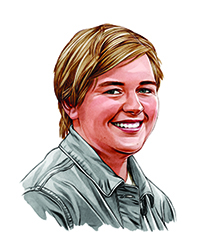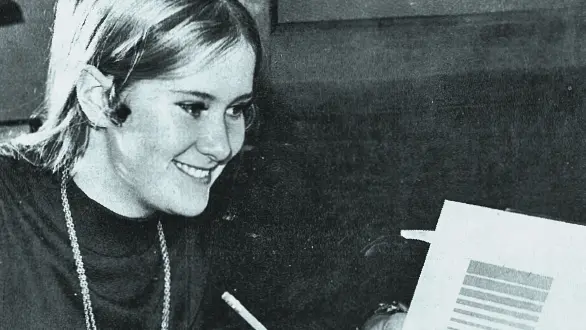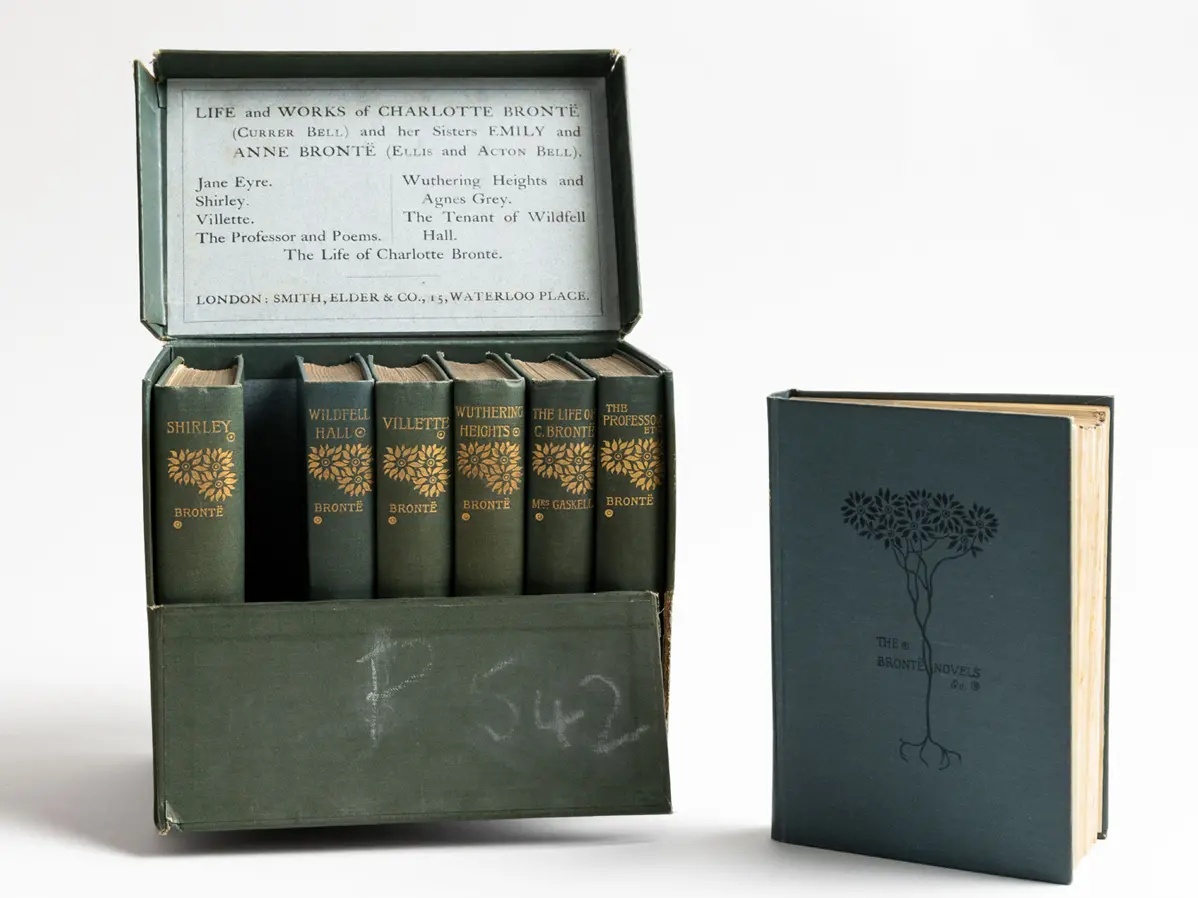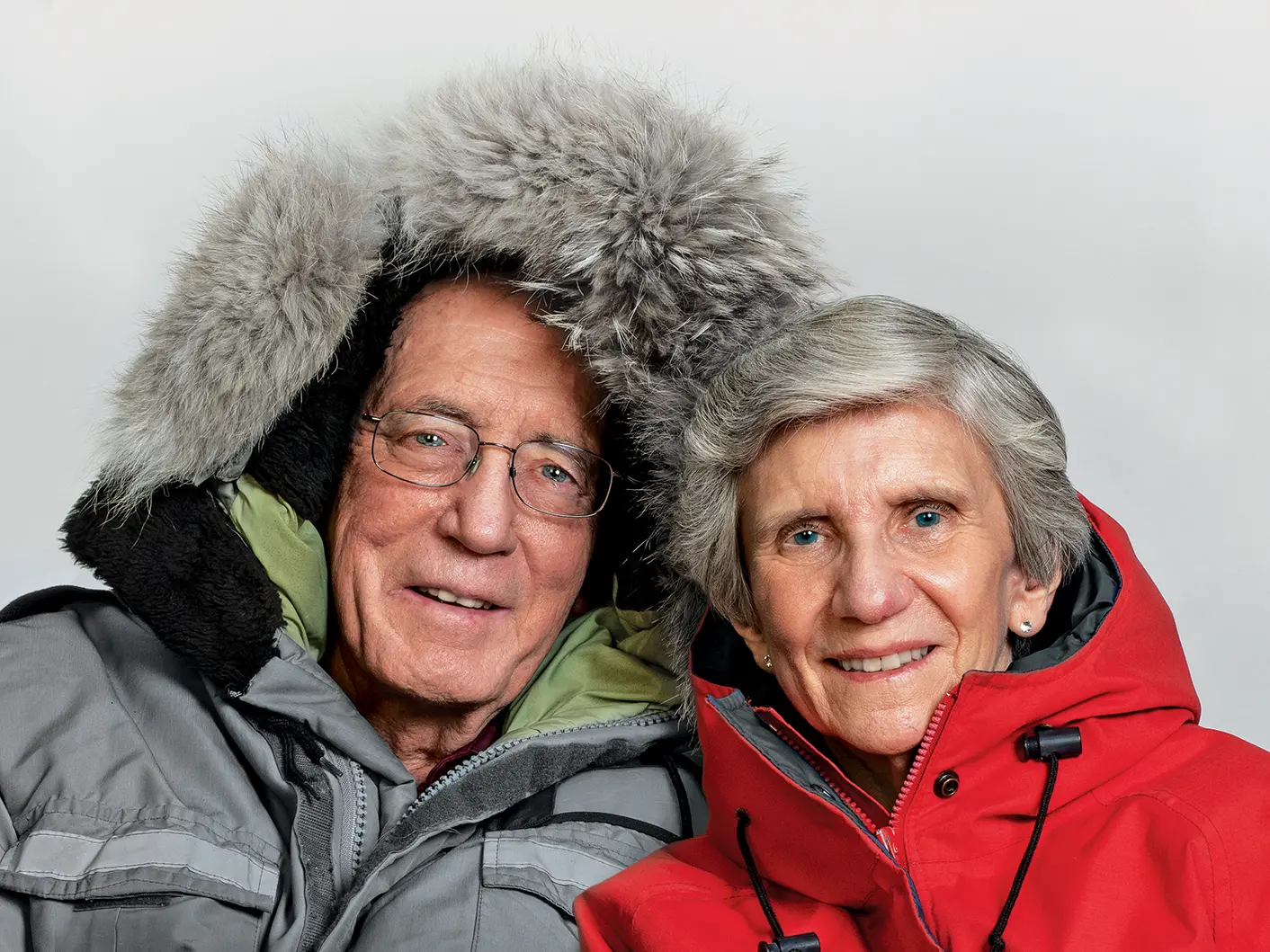Senior finds comfort in alumna’s ’60s experience
The student, in chatting with the creator of Byrd climate research center’s flag, discovered parallels to today’s troubles and the wisdom to carry on.

Byrd Polar and Climate Research Center held a contest in the late 1960s to create its flag, and the winning design, by Susannah Morehead Casey ’70, is still in use today. (Photo by Jodi Miller)
As alumni, you know better than anyone the skills and experience students can gain through college jobs. I’ve also acquired a bit of a new perspective, thanks to an assignment that led to a conversation with 1970 graduate Susannah Morehead Casey.
My job writing and editing for the Byrd Polar and Climate Research Center website is a perfect complement to my English major.

(Illustration by Michael Hoeweler)
Late last summer, I was assigned to write a story about Susannah, who had reconnected with the university after Byrd Center staff discovered she played a role in the center’s history.
As an undergraduate in graphic design, Susannah took first place in a contest to develop the Byrd Center’s flag. Her design has remained relatively unchanged for more than 50 years. My assignment was to capture her story in a way that honored her contribution.
After a few brief emails, Susannah and I met in August over Zoom. I had a handful of questions and she had 50-year-old graphic design tools, homemade quilts, old college projects and a cup of tea to ease her into the early Montana morning. It was 9 a.m. for me and 7 a.m. for her.
Despite the hour, she was bright and friendly. And to my surprise, she was just as curious about me as I was about her. I haven’t often experienced that — interviews in which you share as much as you learn. But she wanted to know my major, my interests, my plans after college. I was charmed by her kind interest before I’d asked a single question.
Eventually I steered the conversation toward her life and discovered a familiar world in the landscape of the late 1960s and early ’70s. In addition to college classes and design projects, her attention was on a war in Southeast Asia that had the country locked in political unrest, much of it centered on college campuses such as Ohio State’s. At home, there were concerns involving racial and gender inequality and the environment. It was a hard time to be a college student, a time filled with uncertainty and worry.

In 1969, Casey shows her winning flag design, inspired by layers of ice at Earth’s poles. (Photo from Byrd Polar and Climate Research Center)
Today, my generation inherits many of these troubles. Inequality continues to rage, and global pressures such as climate change and the COVID-19 pandemic warp our lives. Russia looms large. It can be overwhelming, depressing and painfully mundane. It’s also just more to deal with alongside classes, work and the rest of life.
I worry about the future — both as someone who wants to be alive to see it and someone who wants to make it better. More equitable. More livable. Less of a battleground. More of a haven where life is a joy even with its mishaps and difficulties. That said, I’m still quite young, and it’s easy to lose perspective and get lost in apathy.

work-study job drawing plants for
a botany professor. (Illustration from Byrd
Polar and Climate Research Center)
The cure to ennui is wisdom and satisfaction. I don’t often feel especially wise or satisfied, but speaking with Susannah helped me glimpse a cure. I related to her — beyond the similar characteristics of our eras. Her dream had been to pursue a career in science, but financial concerns and grading errors that took months to resolve led her to choose a different direction. She joined the demanding graphic design program and thrived under its rigor. Her creation of the Byrd Center’s flag was a testament to her growing skills.
Graduation marked a new beginning. She left Ohio, got married and raised a family on the other side of the country. When the Byrd Center staff reached out last year, we reopened a door to Ohio State. What had felt like an abandoned dream became a sense of closure as she discovered that — even without a science degree — she contributed to a research center’s identity and growth. Her work mattered, and I could tell her story.
After 70-odd years of living, Susannah is satisfied. She has a husband, two daughters, two grandkids and a beautiful home next to Flathead Lake. The winding journey that brought her to today has convinced her that our lives will get better, that the sea of troubles we find ourselves in will ease into a glassy lake like the one she lives beside.
I hope for the same wisdom one day. Gaining enough perspective for the worries of the world to feel manageable is a slow process. I’m glad to have had the chance to speak with someone who has had that time. And I’m proud to have offered her a story and the opportunity to stay in touch with Ohio State in return.
Savannah Stearmer was an English major and student assistant at Byrd Polar and Climate Research Center when she wrote this essay. She’s now a 2023 graduate of Ohio State.
Solving a modern-day mystery
Savannah Stearmer’s “History Corner” article — “Who Created the Byrd Center’s Flag?” — is posted on the Byrd Center’s website. Spoiler alert: A roll of toilet paper is what made staff realize they didn’t know how the flag came to be.


